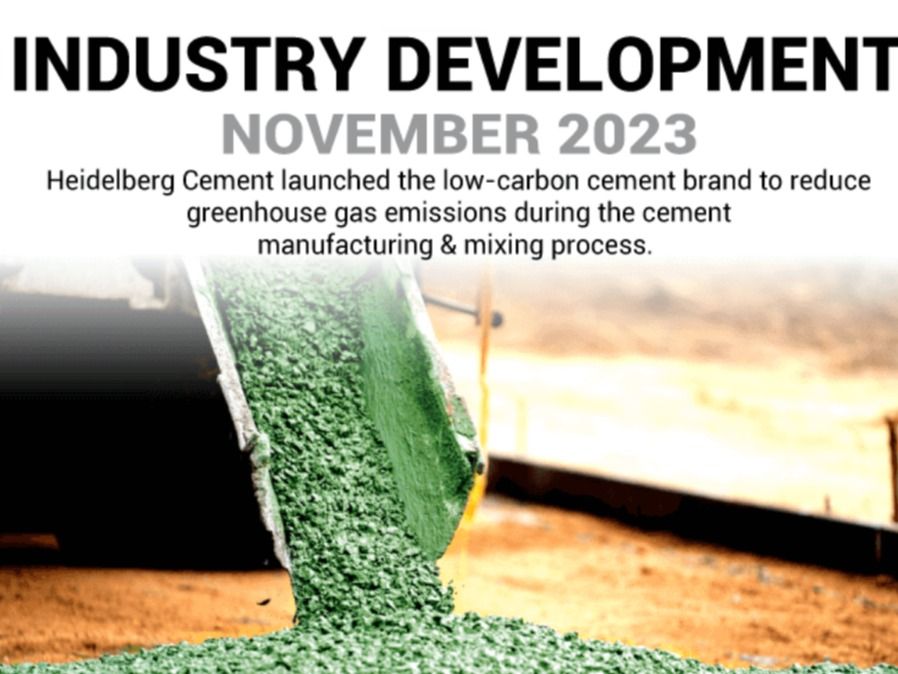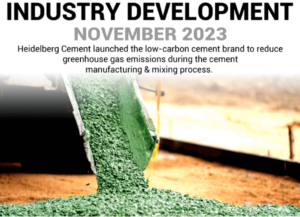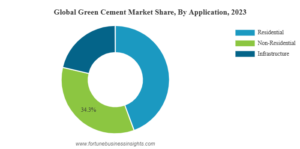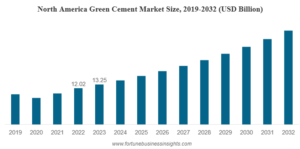
Added: Oct 27, 2025
Last edited: Oct 27, 2025
According to Fortune Business Insights, The global green cement market was valued at USD 35.65 billion in 2023 and is expected to grow from USD 39.32 billion in 2024 to USD 83.28 billion by 2032, registering a CAGR of 9.9% during the forecast period. North America led the global market with a 37.17% share in 2023. In the U.S., the green cement market is anticipated to witness substantial growth, reaching approximately USD 28.89 billion by 2032, fueled by the increasing adoption of sustainable cement alternatives in both residential and non-residential construction projects.
Green cement is an eco-friendly alternative to conventional cement, primarily produced using industrial by-products such as blast furnace slag and fly ash. Its production process is highly energy-efficient, as leading manufacturers employ advanced technologies to minimize carbon emissions. As per JK Lakshmi Cement Ltd., the use of green cement in construction can help reduce carbon footprints by up to 40%, making it a crucial component of sustainable building practices.
The global green cement market is witnessing strong growth as the construction industry increasingly adopts sustainable materials to reduce carbon emissions. Green cement, an eco-friendly alternative to traditional Portland cement, is produced using industrial waste such as fly ash, slag, and recycled aggregates. This shift supports global efforts toward carbon neutrality and sustainable infrastructure development.

Request a FREE Sample Copy: https://www.fortunebusinessinsights.com/enquiry/request-sample-pdf/green-cement-market-107251
Market Overview
The green cement market is projected to experience substantial expansion from 2024 to 2032. Rising environmental awareness, stringent government regulations on carbon emissions, and growing investment in green infrastructure projects are key drivers fueling market growth. Increasing urbanization and demand for energy-efficient buildings further accelerate adoption across residential, commercial, and industrial sectors.
Key Market Drivers
1. Growing Focus on Sustainability and Carbon Reduction
The construction sector is one of the largest contributors to global CO₂ emissions. Green cement reduces carbon output by up to 30–40% compared to conventional cement, aligning with global sustainability goals such as the Paris Agreement. Governments and corporations are actively promoting low-carbon materials to meet green building certification standards such as LEED and BREEAM.
2. Rising Demand in Infrastructure Development
Massive infrastructure projects in emerging economies—such as smart cities, transportation networks, and renewable energy plants—are propelling demand for sustainable building materials. Green cement’s durability and low environmental impact make it an ideal choice for large-scale construction.
3. Technological Innovations and Product Advancements
Continuous R&D has led to innovative formulations of green cement incorporating materials like geopolymers, rice husk ash, and silica fume. These advancements enhance product performance while minimizing clinker usage, further lowering emissions and energy consumption during production.
Market Segmentation
By Type:
Fly Ash-Based Cement
Slag-Based Cement
Recycled Aggregate Cement
Others (Geopolymer Cement, Limestone Calcined Clay Cement, etc.)
By Application:
Residential
Non-Residential (Commercial, Industrial)
Infrastructure (Roads, Bridges, Dams, etc.)
By Region:
North America: Driven by strict environmental policies and green building initiatives.
Europe: Leading in eco-friendly construction standards and carbon-neutral targets.
Asia Pacific: Expected to dominate the market, fueled by rapid urbanization in China, India, and Southeast Asia.
Latin America and Middle East & Africa: Emerging markets showing growing awareness and adoption of sustainable materials.

Regional Insights
Asia Pacific holds the largest market share owing to robust construction activities and government-led sustainability programs. India and China are heavily investing in green infrastructure, supported by public-private partnerships.
Europe continues to be a pioneer in adopting sustainable construction materials, backed by stringent EU environmental regulations.
North America is seeing increased adoption due to corporate ESG commitments and government incentives for green buildings.
Key Industry Players
Leading companies in the global green cement market are focusing on strategic mergers, partnerships, and sustainable manufacturing technologies to strengthen their positions. Major players include:
LafargeHolcim Ltd.
HeidelbergCement AG
CEMEX S.A.B. de C.V.
CRH plc
UltraTech Cement Ltd.
Calera Corporation
Anhui Conch Cement Co., Ltd.
These players are actively investing in carbon capture technologies, alternative fuel use, and waste material integration to meet sustainability targets.
The future of the green cement market looks promising as governments, corporations, and consumers increasingly prioritize sustainability. The demand for carbon-neutral buildings, coupled with the growing use of recycled materials in cement production, will continue to propel market growth through 2032.
The green cement market is set to redefine the global construction industry by offering sustainable, durable, and cost-effective alternatives to traditional cement. As eco-conscious construction practices become the norm, innovations in green cement manufacturing will play a pivotal role in achieving a low-carbon future.

Information Source: https://www.fortunebusinessinsights.com/green-cement-market-107251
KEY INDUSTRY DEVELOPMENTS:
November 2023: Heidelberg Cement launched the low-carbon cement brand to reduce greenhouse gas emissions during the cement manufacturing and mixing process.
October 2022: JSW Cement planned to invest USD 390 million to begin an integrated green cement production facility in Madhya Pradesh and a split grinding unit in Uttar Pradesh. The proposed investment includes a 2.5 MTPA grinding capacity, 15 MW Waste heat recovery system, and 2.5 MTPA clinker capacity.

